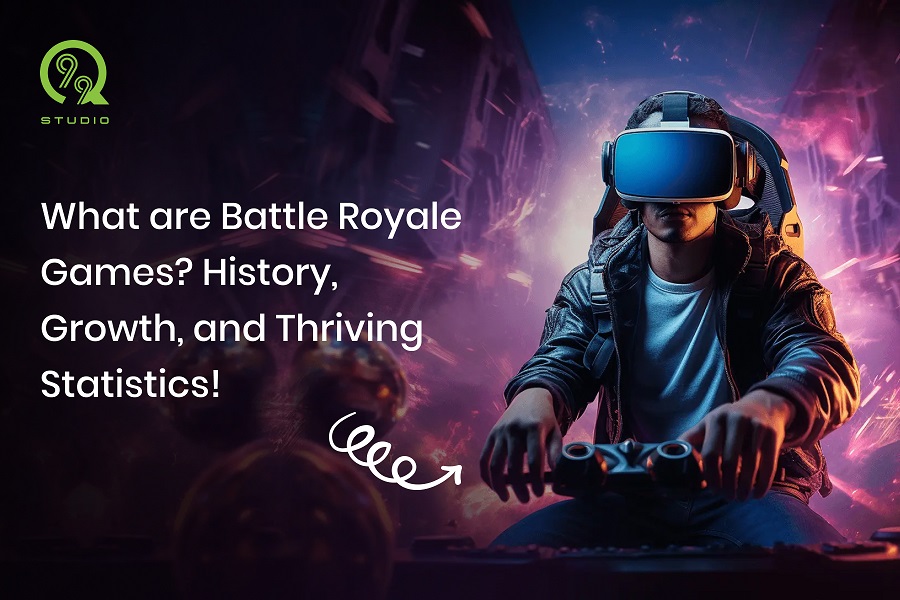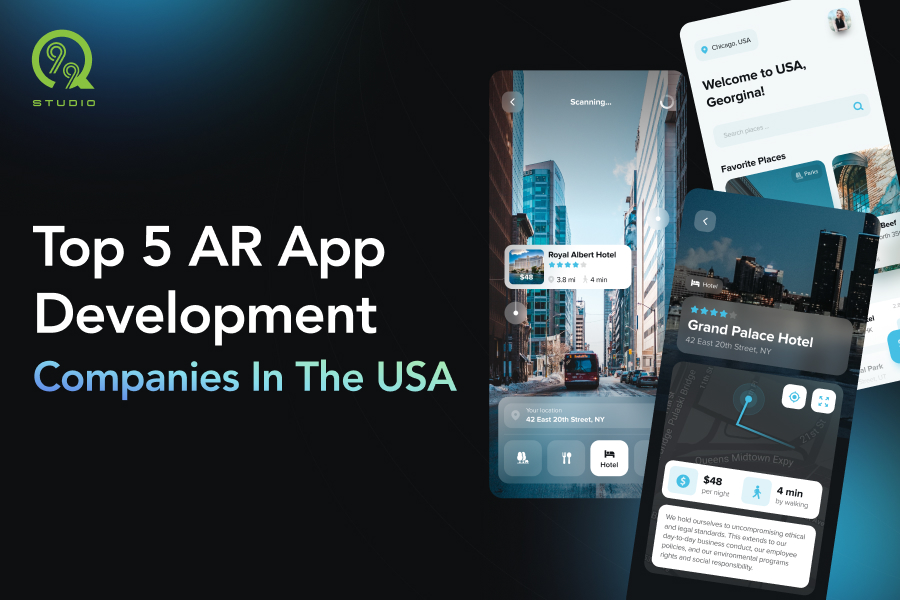In the ever-evolving world of gaming, few genres have captured global attention like battle royale games. These adrenaline-pumping, last-player-standing experiences have redefined multiplayer gaming, drawing millions of players and generating billions in revenue. But what exactly are battle royale games, and how did they become a cultural phenomenon? At Q99 Studio, we’re passionate about crafting immersive gaming experiences, and in this blog, we dive into the history, growth, and thriving statistics of battle royale games, exploring why they continue to dominate the industry.
What Are Battle Royale Games?
Battle royale games are multiplayer video games where players compete to be the last survivor in a shrinking play area. Typically, dozens to hundreds of players are dropped into a large map with minimal resources, scavenging for weapons and items while eliminating opponents. The playable area gradually contracts, forcing players into intense, close-quarters combat until only one player or team remains.
The genre is known for its high-stakes gameplay, strategic depth, and unpredictable outcomes. Popular titles like Fortnite, PUBG: Battlegrounds, and Apex Legends have become household names, blending fast-paced action with elements of survival, exploration, and teamwork. Whether you’re a casual gamer or a competitive esports enthusiast, battle royale games offer something for everyone.
The History of Battle Royale Games
The battle royale genre draws its name and inspiration from the 200λέ Japanese film Battle Royale, where characters fight to the death in a confined space. However, its gaming roots trace back to earlier survival and multiplayer concepts.
Early Inspirations (2000s–2010s)
The genre’s foundation lies in mods for existing games. In 2012, the DayZ mod for ARMA 2 introduced survival mechanics in a large, open world, pitting players against zombies and each other. Around the same time, Minecraft’s Hunger Games mode, inspired by the popular book and film series, had players scavenging and fighting in a shrinking arena—a precursor to modern battle royale mechanics.
The real breakthrough came with Brendan Greene’s DayZ: Battle Royale mod for ARMA 3. Greene, inspired by Battle Royale and survival games, created a standalone version called H1Z1: King of the Kill in 2016, which formalized the last-player-standing concept.
The Birth of Modern Battle Royale (2017–2018)
In 2017, PUBG: Battlegrounds (originally PlayerUnknown’s Battlegrounds), developed by Greene and PUBG Corporation, took the world by storm. Its realistic graphics, tactical gameplay, and 100-player matches set the standard for the genre. PUBG sold over 70 million copies by 2020 and peaked at 3.2 million concurrent players on Steam in 2018.
Hot on PUBG’s heels, Epic Games released Fortnite: Battle Royale in 2017 as a free-to-play title. With its colorful art style, building mechanics, and cross-platform accessibility, Fortnite became a cultural juggernaut, attracting players of all ages and spawning dance emotes that went viral. By 2018, Fortnite had over 125 million players and generated $5.6 billion in revenue.
Expansion and Diversification (2019–Present)
The success of PUBG and Fortnite sparked a wave of battle royale titles. Apex Legends (2019) by Respawn Entertainment introduced hero-based gameplay and squad dynamics, amassing 50 million players within a month. Call of Duty: Warzone (2020) blended the franchise’s fast-paced gunplay with battle royale mechanics, reaching 100 million players by 2021. Other notable titles include Free Fire, a mobile-first battle royale dominating markets in Asia and Latin America, and Fall Guys (2020), which offered a lighthearted, obstacle-course twist on the genre.
The Explosive Growth of Battle Royale Games
The battle royale genre’s growth is nothing short of remarkable, driven by accessibility, innovation, and community engagement.
Accessibility and Free-to-Play Models
Many battle royale games, like Fortnite, Apex Legends, and Warzone, are free-to-play, lowering the barrier to entry. Monetization through in-game cosmetics, battle passes, and seasonal events keeps players invested without pay-to-win mechanics. Mobile titles like PUBG Mobile and Free Fire have further expanded the genre’s reach, with Free Fire alone boasting over 1 billion downloads by 2021.
Technological Advancements
Advancements in game engines like Unreal Engine and Unity have enabled developers to create expansive, visually stunning maps with seamless multiplayer functionality. Cloud gaming and cross-platform play have made battle royale games more inclusive, allowing players on PC, consoles, and mobile devices to compete together. Real-time voice chat and social features enhance teamwork, making every match a shared adventure.
Esports and Streaming
Battle royale games have become a staple of esports and streaming culture. Tournaments like the Fortnite World Cup (2019), which offered a $30 million prize pool, showcase the genre’s competitive potential. Platforms like Twitch and YouTube Gaming thrive on battle royale content, with streamers like Ninja and Tfue amassing millions of followers by playing Fortnite and Warzone. This visibility fuels the genre’s popularity, attracting new players daily.
Thriving Statistics of Battle Royale Games
The numbers behind battle royale games highlight their dominance in the gaming industry:
- Player Base: Fortnite reported 350 million registered players by 2020, while PUBG Mobile crossed 1.3 billion downloads by 2022. Apex Legends hit 130 million players by 2023.
- Revenue: Fortnite generated $9 billion in revenue from 2018 to 2019, per Epic Games. PUBG Mobile earned $8.1 billion by 2023, making it one of the highest-grossing mobile games.
- Engagement: Warzone players logged over 2.4 billion hours of playtime in its first year (2020–2021). Free Fire peaked at 150 million daily active users in 2021.
- Market Share: Battle royale games accounted for 13% of global gaming revenue in 2022, according to Newzoo, with mobile battle royales driving significant growth in Asia.
- Esports Impact: The Fortnite esports scene distributed over $100 million in prize money from 2018 to 2022, per Esports Earnings.
These stats underscore the genre’s staying power and its ability to captivate diverse audiences worldwide.
The Future of Battle Royale Games and Q99 Studio’s Vision
The battle royale genre shows no signs of slowing down. Emerging trends include integrating battle royale modes into existing franchises (e.g., Battlefield 2042), leveraging virtual reality for immersive experiences, and incorporating AI-driven NPCs for dynamic gameplay. Blockchain and NFT-based cosmetics are also gaining traction, though they remain controversial.
At Q99 Studio, we’re at the forefront of gaming innovation, crafting experiences that push boundaries. Our team specializes in developing engaging, high-performance games, including battle royale-inspired projects that blend cutting-edge technology with creative storytelling. Whether you’re a studio looking to create the next big battle royale hit or a business exploring gamified marketing, Q99 Studio has the expertise to deliver.
Conclusion: Join the Battle with Q99 Studio
Battle royale games have transformed gaming, offering thrilling, community-driven experiences that resonate globally. From their humble mod origins to billion-dollar franchises, these games continue to evolve, driven by innovation and player passion. With thriving statistics and a bright future, the genre is here to stay.
Ready to create your own gaming masterpiece or leverage battle royale excitement for your brand? Contact Q99 Studio today to explore our game development services and bring your vision to life in the ultimate battle arena!







 B - 433-442, Money Plant High Street, Near Ganesh Glory, Jagatpur Road, S.G. Highway, Ahmedabad - 382470.
B - 433-442, Money Plant High Street, Near Ganesh Glory, Jagatpur Road, S.G. Highway, Ahmedabad - 382470.
 11006 Kirker Ln, Richmond, TX 77407, USA
11006 Kirker Ln, Richmond, TX 77407, USA



